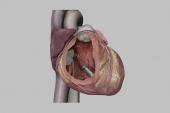Micra Leadless Pacemaker Performs Well Through 5 Years
A real-world registry saw few complications and revisions, with no device removals due to infection, which is “a huge finding.”

Photo Credit: Adapted from Brown K. TCT 564: A new perspective: intracardiac echocardiographic guidance for the implantation of a left atrial appendage occluder device (Watchman) with a leadless pacemaker (Micra). Presented at: TCT 2021. Orlando, FL.
The Micra VR leadless pacemaker (Medtronic) continues to have a good safety and efficacy profile through the 5-year mark, according to real-world registry data.
Rates of major complications and revisions were both under 5%, and no patients required device removal for infection.
Moreover, as researchers led by Mikhael El-Chami, MD (Emory University, Atlanta, GA), report in a study published online recently in the European Heart Journal, complication and revision rates at 3 years were roughly half those seen in several studies of patients who had received conventional transvenous pacemakers.
Leadless pacemakers are still relatively new, with the Micra transcatheter pacing system receiving approval from the US Food and Drug Administration in 2016, El-Chami noted. Thus, he said, it’s important to confirm that the favorable safety and efficacy results observed in earlier studies are sustained over longer-term follow-up.
And through 5 years, “the leadless system studied in this paper seems to be very safe with very low complications,” El-Chami told TCTMD.
But the most important result, he said, is the lack of device removals for infections, “which I think is a huge finding.”
The study also provides insights into how physicians are managing these devices at the end of their life cycles when the battery is depleted or the patient requires an upgrade to a transvenous pacemaker or cardiac resynchronization therapy (CRT) device. “As this registry shows,” El-Chami said, “it’s safe to leave this device turned off or as a backup, and a small percentage of these devices were removed successfully and a new device was placed.”
Commenting for TCTMD via email, Panos Vardas, MD, PhD (University of Crete, Heraklion, Greece), who wrote an accompanying editorial, pointed out that the Micra VR leadless pacemaker “is essentially the only device in long-term clinical use. Therefore, studying its results regarding pacing and sensing outcomes and potential complications or failures requires a sufficient follow-up time. A 5-year period undoubtedly offers reliability in our conclusions.”
Micra Postapproval Registry
For the study, El-Chami and his colleagues looked at data from the Micra postapproval registry, which enrolled patients who had an attempted implant of the Micra VR leadless pacemaker from July 2015 and March 2018 across 179 centers in 23 countries. Investigators will follow patients for 9 years, but this prespecified analysis provides a snapshot at 5 years of follow-up (median 51.1 months) in 1,809 patients (mean age 75.6 years; 38.8% women). All had a class I or II indication for pacing, most commonly bradyarrhythmia with atrial fibrillation (AF), at 62.6%. The Micra VR implant was successful in 99.1%.
At 5 years, the rate of system- or procedure-related major complications was 4.5%, with most of the events (58.8%) occurring in the first 30 days after the pacemaker implant. The rate of system revision for any cause was 4.9%, with the most frequent reasons being a device upgrade to a dual-chamber or CRT device (41.2%) or elevated pacing thresholds (30.6%). Although there were nine infections identified during follow-up, none resulted in removal of the pacemaker.
Of note, the authors report, “only 12 patients had battery depletion occurring in the setting of elevated thresholds. The median projected battery longevity of patients by the end of 5 years of follow-up was 6.8 years and in line with the initial projection of a 12.1-year median battery life observed in the Micra VR IDE study.”
That’s reassuring, they say, adding that a second-generation device has an expected battery life of 17 years.
The FDA had previously sent a letter to healthcare professionals, in 2021, warning about the risk of major complications if perforation were to occur during implantation of the device. In the postapproval registry, there were eight cases of cardiac effusion/perforation recorded around the time of implantation.
El-Chami et al also compared the results observed in this registry through 3 years with those from 2,667 recipients of Medtronic-made transvenous pacemakers who participated in six prior studies. The Micra leadless pacemaker was associated with lower rates of both major complications (4.1% vs 8.5%; HR 0.47; 95% CI 0.36-0.61) and revisions (3.2% vs 6.6%; HR 0.47; 95% CI 0.34-0.65).
Pros and Cons of Leadless Pacemakers
El-Chami said there are two major advantages of leadless pacemakers, as highlighted in this study: one is the avoidance of complications associated with lead dysfunction and dislodgement seen with traditional transvenous systems and the other is the lower risk of infection requiring system removal.
But there are some potential downsides as well, he said, noting that when a leadless pacemaker reaches the end of its battery life, a new one will have to be implanted or the patient will have to be switched to a transvenous system. In contrast, when the battery runs out in a transvenous pacemaker, it can be replaced.
In addition, the Micra device is a single-lead pacemaker at this point, El-Chami said. There is a dual-chamber leadless pacemaker now available—the Aveir DR device (Abbott), approved last year by the FDA—but it’s still in the early phase of use, he pointed out. And there are currently no leadless systems that can provide CRT or conduction system pacing.
At this point, El-Chami said, patients best suited for leadless pacing are those at high risk for infection—for example, those who require dialysis, have a history of infection, or are immunocompromised. For patients who have an expected high burden of pacing or who require CRT, dual-chamber, or conduction system pacing, on the other hand, a traditional transvenous system may still be preferred, he said.
Vardas said that the categories of patients who will benefit most from leadless pacing will evolve over time along with the capabilities of the devices. Currently, however, the best candidates are those with permanent AF and atrioventricular block; those who require infrequent pacing or who have significant reasons to avoid visible scars on the chest; and those who have poor access to the right heart chambers through the venous network due to comorbidities.
“Currently, the primary challenge with leadless pacing is the inability to pace the atrial myocardium, while sensing from the later remains also unfeasible,” Vardas said.
He pointed out that devices made by Medtronic and Abbott continue to improve. These companies “have developed models of leadless pacing addressing the issue of restoring atrioventricular synchrony in patients with satisfactory sinus function,” he said. “However, comparative studies between these latest models of leadless pacing AV synchrony and traditional atrioventricular pacing and sensing are needed to evaluate the performance and long-term reliability of these new devices.”
Additional issues that require investigation over the longer term, Vardas said, include how to handle middle-aged patients who require pacing since they may need to have devices replaced eventually; the possibility of thrombogenesis when multiple devices are implanted within the right ventricle; and device removal when the batteries run out.
Indeed, El-Chami said, there remains a need for even more follow-up of patients implanted with leadless pacemakers. “We’re still in the early phases of the leadless system,” El-Chami said. “While 5 years is a good point to have, we need longer-term follow-up.”
Todd Neale is the Associate News Editor for TCTMD and a Senior Medical Journalist. He got his start in journalism at …
Read Full BioSources
El-Chami MF, Garweg C, Clementry N, et al. Leadless pacemakers at 5-year follow-up: the Micra transcatheter pacing system post-approval registry. Eur Heart J. 2024;Epub ahead of print.
Vardas PE. Leadless and scarless pacing: towards symbiotic nanogenerators. Eur Heart J. 2024;Epub ahead of print.
Disclosures
- The Micra VR Post-Approval Registry is funded by Medtronic.
- El-Chami reports consulting for Medtronic, Boston Scientific, and Biotronik.
- Vardas reports no relevant conflicts of interest.





Comments